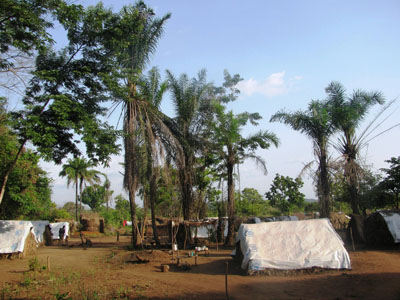
News reports about violence in the Central African Republic this week stated that the Lord’s Resistance Army attacked the towns of Mboki and Zemio in south-eastern corner of the country. Many people were apparently killed in Mboki and 50 kidnapped. Sources on the ground in CAR said, however, that the biggest attack took place in Rafai on Monday, 125 miles west of Zemio. As the discrepancies illustrate, reports on attacks in CAR are scarce and often conflicting, creating an impression that the LRA is not very active there. However, during a recent research mission in southern CAR, I found that LRA violence has been persistent and continues to spread westward despite a strong Ugandan army presence there.
The first in the series of attacks took place in Mboki last Friday night, March 19 and the next morning. At least two people were seriously injured and another one died.
The second attack took place in Zemio, 85 miles west of Mboki on Sunday. Three armed men wearing military uniforms were seen in town around 1 in the afternoon. Zemio residents, armed with locally manufactured guns and bows and arrows, understood immediately who the intruders were – many in Zemio are internally displaced or Congolese refugees who left their homes due to LRA violence – and chased them away. It is believed the three men were part of a reconnaissance LRA team and that a bigger group was waiting outside of town to attack later in the evening.
The third attack occurred in the town of Rafai on Monday. At least 10 people were killed and 50 kidnapped. One LRA fighter was caught by the population and burned alive. This was the second LRA attack in Rafai this year. The previous attack happened almost exactly a month before on February 21, and more than 50 people were abducted. During the February attack, the LRA specifically targeted the Catholic mission there, stealing solar panels and the multi frequency radio, and looting or destroying almost everything else. Monday’s attack targeted Rafai’s small market; the LRA were clearly after food.
It is not a surprise that Zemio was targeted by the LRA. During my stay there less than two weeks ago, it was clear that people were expecting an LRA attack. Many were wondering why Zemio had not been attacked before when almost every surrounding town and village had been targeted by the LRA. Zemio is also home to 3,000 Congolese refugees who escaped attacks in northern Bas Uele district and about 500 internally displaced people also escaping LRA violence. The absence of the Ugandan army and the Central African army and police in the town meant the refugees and IPDs were easy targets for the LRA. To make matters worse, a convoy from the U.N.’s World Food Program delivered food to refugees and IDPs in Zemio on March 16. It is almost certain that attacks in Zemio and Mboki, where there was a food delivery on March 19, were related to the WFP supplies. The Ugandan army apparently deployed immediately to Zemio after the LRA sightings which has ensured a level of security in town.
The attack in Mboki is puzzling. Mboki has one of the strongest self-defense forces in all of eastern CAR. The self-defense force there was created after an LRA attack on July 24, 2009. In the attack last summer, the residents of Mboki responded with bows and arrows when the LRA approached the town’s market. The LRA killed six people, including two Congolese refugees, but three LRA were also killed by the local population. When I was recently in Mboki, there were at least 50 Ugandan soldiers, about 10 CAR soldiers, and 5 police. It is surprising that the LRA would attack a town with so many armed defenders.
Contrary to the claims of officials in the region, it’s clear the LRA is not dwindling. Almost simultaneous attacks in different towns hundred of miles apart in both CAR and neighboring Congo indicate the presence of many different groups. It is also becoming obvious that the Ugandan army alone is not able to finish them off. A regional strategy to contain this regional problem is urgently needed.

